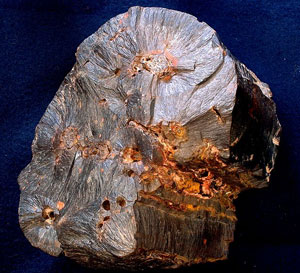by Russ Humphreys
Evidence from the pre-Flood world suggests that we need not fear global warming from carbon dioxide
CO2 is vital for life on earth, and we are currently in a CO2 drought. There is good evidence for much more atmospheric CO2 before the flood. This would have promoted improved plant growth and productivity.
For more details watch the entire episode here:
https://youtu.be/zvFTk42bPYg
Related article posted below from Creation Ministries International
Governments today are trying to reduce carbon dioxide (CO2) emissions into the air, because they fear that the greenhouse effect (which traps heat trying to leave the earth) of CO2 will trigger a global climate catastrophe. They point to computer simulations suggesting that result. But the evidence suggests that about 6,000 years ago God created the world with large amounts of carbon dioxide in the atmosphere. This lasted 1,656 years, from Creation until the Genesis Flood. The rocks and fossils laid down by that flood suggest that the result was very beneficial, with no climate catastrophe, as we shall see.
Mythbusters needed!
Aside from disposing of the main climate-change myth, that CO2 brings catastrophe, we first need to debunk a few secondary myths from both sides of the debate:
Myth 1: CO2 is a pollutant.
Wrong. Other things coming out of smokestacks and car exhausts are indeed pollutants; things both harmful and undesirable. Examples are:
- Sulfur dioxide, which returns to us as sulfuric acid in rain, and
- Soot, particles of carbon that blacken the landscape and get into our lungs.
Such pollutants can be greatly reduced, and should be. But carbon dioxide, a colorless, odorless gas, is a God-designed part of the cycle of life. We do (and must) exhale it with every breath. Plants do (and must) “inhale” it in order to make all of their solid tissue: leaves, wood, bark, roots, fruit, seed, etc. It is amazing that the green we see around us comes from the tiny amount of carbon dioxide in the air today: 387 parts per million, just 0.0387% of all the molecules in the air (as at March 2009). The amount of CO2 in the air would have to increase some hundredfold, say to 30,000 parts per million (3%), before it would become a problem to our breathing.
Higher CO2 levels actually improve plant growth and productivity. There has been a substantial increase in the productivity of the world’s crops and forests due to the increased carbon dioxide concentrations, contributing to the food and fiber production to meet the needs of the growing human population.1
Myth 2: CO2 is not increasing.
Wrong. Scientific records show a clear increase of 30% since 1880 and 22% from 1958 to 2007, the period of direct measurement. The measurements are not difficult to make or interpret. Moreover, we would expect roughly that amount of increase from the total volume of CO2 being released into the air. Debunkers of anthropogenic (man-caused) global warming (AGW) should focus on other points.
Myth 3: The earth is not warming.
Analysis of temperatures from many locations, excluding those affected by urban growth,2 show a slight average (see Myth 4) global increase over the last century of about 0.5 degrees C. Whether this increase is due to normal climate cycles over the centuries, changes in the Sun’s activity,3 natural CO2 emissions, or man-caused CO2 emissions is the subject of fierce debate. However, the earth began warming following the end of “The Little Ice Age” (about 1850), well before the increase in CO2 levels due to burning fossil fuels.4 In fact, global temperatures have fallen over the past eight years, despite increases in emissions.
We would appreciate your donation.

Photo by Eurico Zimbres, Wikipedia.org
Figure 2. Goethite, an iron oxide mineral, retains carbon dioxide present when it forms. Goethites in Ordovician strata (buried very early in the Flood) show a world with fifteen times more CO2 in its atmosphere than today. Other studies show this was common in Paleozoic (first months of Flood) strata.8
A simplistic approach would suggest that increased carbon dioxide levels should increase global temperature, but the existence of 10 times current levels before the Flood without runaway warming suggests that the current and likely increases will not have a major effect.5
Myth 4: Global warming must mean hotter tropics.
Not necessarily. Much of the earth is cool year-round, such as the poles and high latitudes. Most of the ocean, below a depth of a few hundred feet, is barely above freezing. We could increase the temperatures of just those cool parts without warming the tropics and increase the average global temperature a great deal. In fact, most climate measurements appear to show a greater warming trend at high latitudes than in the tropics. In his movie, An Inconvenient Truth, Al Gore6 fails to make the distinction. Perhaps he found that particular truth inconvenient!
Myth 5: Melting icecaps will drown the continents.
Wrong. In the last 100 years the sea level has risen by 180 mm (7 inches). In the unlikely event that all the ice melted and the temperature increased as much as the highest temperature climate model predictions (warming also causes thermal expansion of the ocean water), the oceans would rise by a few dozen meters. That would reduce the land area of the continents by a few percent. Of course this would affect people living in low-lying coastal areas but there would be plenty of other land above sea level.
Myth 6: Global warming is making weather more violent.
Records of storm frequency and intensity show no increase in the violence of weather events such as hurricanes/cyclones and tornados. The number of severe tornados in the USA, for example, has declined 43% between 1950 and 2006.7
God’s created climate before the Flood?
Minerals from deep geologic strata indicate there was a time in the past when the earth’s atmosphere had much more carbon dioxide than it now has (see Figure 2 and Reference 8). Fossil plants (Figure 3) from the same strata show the world was indeed warmer—at the poles, not the equator. The fossils reveal a very green, wet world, teeming with animals and plants. There was likely plenty of land area available, with a lack of glaciers and polar ice caps and correspondingly higher sea levels. In fact, there seems to have been much less desert, and much more plant-growing land in higher latitudes than we have today.
The lesson we should learn is that higher carbon dioxide in the air and global warming are good things, not bad … unless you live on low-lying coastal land!
Some secular geoscientists are aware of the higher CO2 levels in the past, but they are not generally speaking out against the prevailing “politically correct” policies, which are trying to limit carbon dioxide emissions to prevent global warming. Part of their silence may be due to fear of the science establishment, but it may also stem from lack of understanding of why the world of the fossils had so much more carbon dioxide than today’s world. To the secular scientist, it is a mystery.
Creation explains the mystery

Photo by Don Batten
Figure 3. Fossils of tropical plants like this modern fern are often found in areas that were near the North or South poles. Photo of Dickensonia antarctica
Creation scientists, on the other hand, have in the Bible a much better foundation for understanding these things. We know that the Genesis Flood buried many land plants and animals (except those land animals on Noah’s ark). That accounts for most of the fossils and other forms of carbon deep in the earth, such as coal, oil, natural gas, limestone, etc.9 The fossils are a snapshot of life on Earth the day Noah stepped aboard the ark. Today there is at least 100 times more fossil carbon in the earth’s crust than is in the earth’s biosphere (air, sea, lakes, rivers, soil, plants, and animals).10 That means the earth’s biosphere before the Flood was teeming with life, filled with vegetation and creatures feeding on it. This, apart from the effects of sin, was the world God called “very good” just after creating it (Genesis 1:31).
Having much more carbon available than today, the pre-Flood biosphere cycled more carbon dioxide to and from its various parts. For example, plants took CO2 out of the air by photosynthesis. Then after dying, the plants returned CO2 back to the air by decaying (respiration of microorganisms). So the carbon-rich pre-Flood atmosphere would have much more CO2, just as minerals such as goethite suggest. The greenhouse effect of the very much higher carbon dioxide levels (15 times current) probably contributed to a warm, relatively uniform climate over the whole earth, just as the fossils show. Warmer oceans provided more moisture to the air, which in turn provided more rain. With more available CO2, water, and warmth, plants thrived. More tropical weather at high latitudes and fewer deserts (if any) meant much more of the land surface was suitable for plant and animal life. God designed the whole system, including the soil, to be rich in carbon and consequently sustaining abundant plant and animal life.
Why fear climate change?
A creationist atmospheric scientist, Dr. Larry Vardiman, once explained to me why the secular experts are so afraid of “climate change”. They fear the atmosphere is unstable because of their theory of the Ice Age (one Ice Age for creationists, many for people misinterpreting carbon-14 dating). Their model, the Milankovitch theory, depends on variations in the earth’s orbit and seasonal tilt of its spin axis.11 The “push” on the climate from such variations would be weak, which makes secular climatologists think the earth’s climate is unstable, needing only a slight disturbance to “trigger” a disaster. The recent movie, The Day after Tomorrow,12 takes such a catastrophe as its major premise, plunging the world into simulated Antarctic weather. The experts fear that a somewhat stronger “push”, such as a moderate global CO2 increase, might be enough to cause a climate collapse.
Creationists, however, have received a good understanding of the post-Flood Ice Age from former U.S. Weather Service forecaster and present Ice Age expert Michael Oard.13 His theory depends on a very powerful “push”, the warming of the oceans by the “fountains of the great deep” during the Genesis Flood.14 More warmth would cause more moisture from the oceans that would cause more snow in the higher latitudes. More snow in the summer would reflect heat into space, and start buildup of the glaciers. Dust from Flood and post-Flood volcanoes would help cool the earth. The glaciers would persist until the oceans cooled about 700 years later. This theory explains many of the observed features of the Ice Age, such as the existence of temperate, wet, land corridors along the northern coasts of northern Europe and America between the warm sea and the glaciers.15
The main point is that the earth’s climate appears to be quite stable, not “triggerable”. Instead, it required a very robust and one-time cause, the Genesis Flood, to produce the Ice Age. Adding a little more carbon dioxide to the atmosphere shouldn’t bring a catastrophe.
The days after tomorrow
So we should not fear “global warming”. God created a world with much more carbon dioxide in the air—a lush green world. Such a world was indeed warmer on the average, equators being about the same as now, but poles much warmer. Scripture speaks of a future “period of restoration of all things” (Acts 3:21). It is ironic that our technology is pumping carbon buried by the Flood back into the earth’s biosphere, perhaps in preparation for a time when the earth will again be like Eden—at least in terms of the climate.
Editor’s note: This article prompted an additional correspondent to write, which can be seen together with our response at Bring on the hecklers?
SOURCE: CREATION MINISTRIES INTERNATIONAL





